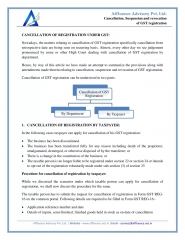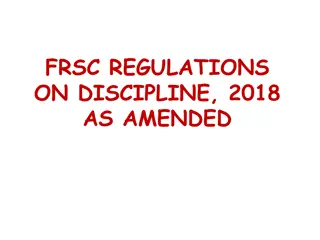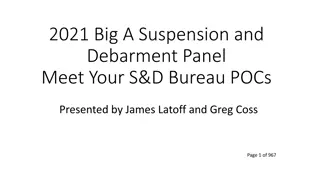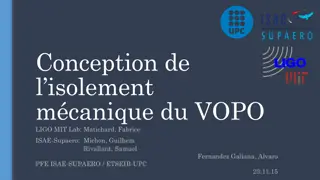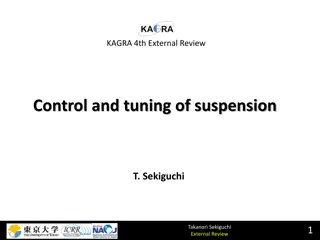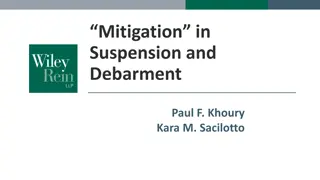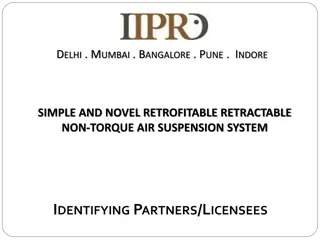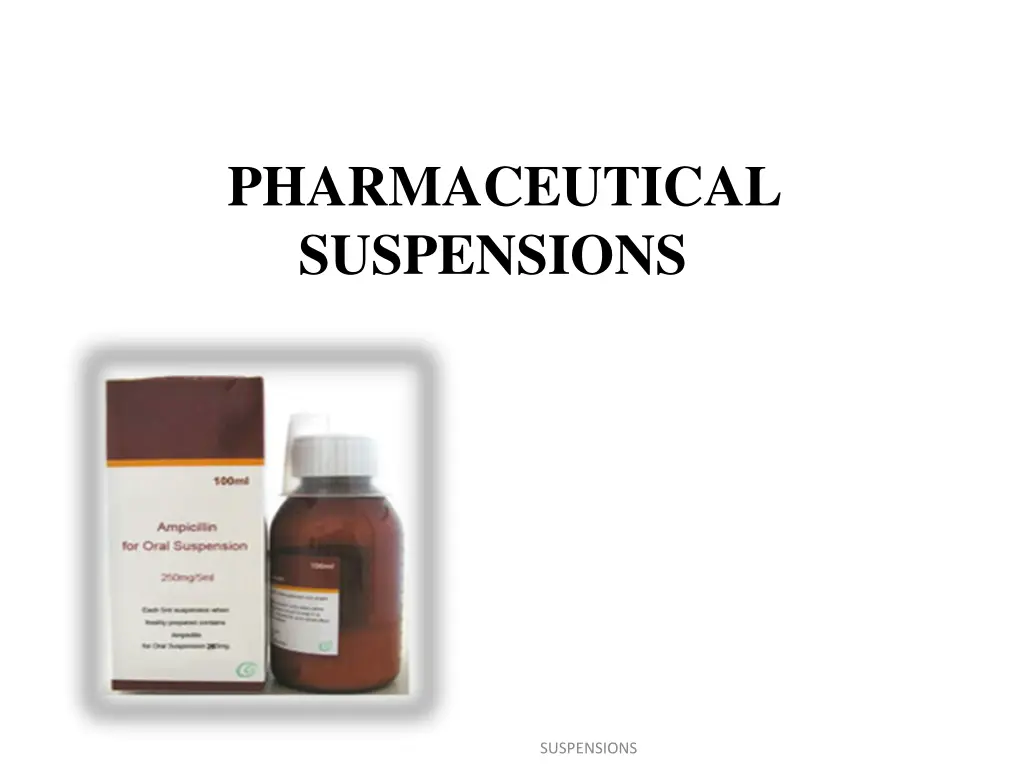
Understanding Pharmaceutical Suspensions
Pharmaceutical suspensions are heterogeneous systems consisting of two phases - internal phase (therapeutically active ingredient) dispersed uniformly in an external phase. These suspensions consist of insoluble solid particles with sizes ranging from 0.5 to 5 microns, maintained in a suspending vehicle with the help of suspending agents. Learn about the definition, characteristics, and differences with solutions in pharmaceutical suspensions.
Download Presentation

Please find below an Image/Link to download the presentation.
The content on the website is provided AS IS for your information and personal use only. It may not be sold, licensed, or shared on other websites without obtaining consent from the author. If you encounter any issues during the download, it is possible that the publisher has removed the file from their server.
You are allowed to download the files provided on this website for personal or commercial use, subject to the condition that they are used lawfully. All files are the property of their respective owners.
The content on the website is provided AS IS for your information and personal use only. It may not be sold, licensed, or shared on other websites without obtaining consent from the author.
E N D
Presentation Transcript
PHARMACEUTICAL SUSPENSIONS SUSPENSIONS
WHAT ARE SUSPENSIONS? WHY WE ARE USING SUSPENSIONS? SUSPENSIONS 2
DISPERSE SYSTEM The term "Disperse System" refers to a system in which one substance (The Dispersed Phase) is distributed, in discrete units, throughout a second substance (the continuous Phase ). Each phase can exist in solid, liquid, or gaseous state . Suspensions are heterogenous system consisting of 2 phases. SUSPENSIONS 3
Dispersion Dispersion medium liquid, or solid, in which a disperse called continuous phase phase, external phase medium. The continuous medium disperse phase medium, such as a gas, phase is distributed. Also phase. DISPERSE SYSTEM DISPERSED MEDIUM DISPERSED PHASE oAqueous, oily liquid oInsoluble solid SUSPENSIONS 4
A solid in liquid dispersion in which the particles are of colloidal size. (Collaidal refers to items of a small size are floating in amedium of one of three substances;a solid , a liquid , or a gas) SUSPENSIONS 5
Definition A Pharmaceutical suspension is a coarse dispersion in which internal phase (therapeutically active ingredient)is dispersed uniformly throughout the external phase. SUSPENSIONS 6
The internal phase consisting of insoluble solid particles having a range of size(0.5 to 5 microns) which is maintained uniformly through out the suspending vehicle with aid of single or combination of suspending agent. The external phase (suspending medium) is generally aqueous in some instance, may be an organic or oily liquid for non oral use. SUSPENSIONS 7
The Difference Between Solution & Suspensions When the 2 substances totally mix it is called a solution. E.g. Solute + Solvent = Solution (sugar) + (water) = Solution We then say sugar is soluble in water, it has dissolved.
The Difference Between Solution & Suspensions Suspensions Sometimes when we mix substances they stay in clusters. We therefore say it is insoluble in water. E.g. Chalk + Water = Suspension Eventually the particles sink to the bottom to form sediment.
Why suspensions? Against Against solid If patient has a difficulty of swallowing solid dosage forms (a need for oral liquid dosage form). Faster rate of dissolution and oral absorption than solid dosage forms, yet slower than solutions. Bulky insoluble powders as kaolin or chalk are better formulated as suspensions so that they are easier to take. solid dosage dosage forms forms: : SUSPENSIONS 10
Why suspensions? Against Against solutions solutions: : Drugs that have very low solubility are usefully formulated as suspensions. Drugs that have an unpleasant taste in their soluble forms (e.g., chloramphenicol (soluble) vs. chloramphenicol palmitate (insoluble )). Prolongation of effect (e.g. I.M and S.C. suspensions). Stability and instability issues: Insoluble forms of drugs may prolong the action of a drug by preventing rapid degradation of the drug in the presence of water (e.g., Oxytetracycline hydrochloride (soluble, hydrolyses rapidly) vs oxytetracycline calcium salt (insoluble, stable). Non-aqueous suspensions (tetracycline hydrochloride in coconut oil) Reconstitution (ampicillin suspension). SUSPENSIONS 11
The reasons for the formulation of a pharmaceutical suspension: -- when the drug is insoluble in the delivery vehicle. To mask the bitter taste of the drug. To increase drug stability. To achieve controlled/sustained drug release. SUSPENSIONS 12
SOME MARKETED SUSPENSIONS SOME PHARMACEUTICAL SUSPENSIONS 1. Antacid oral suspensions 2. Antibacterial oral suspension 3. Dry powders for oral suspension (antibiotic) 4. Analgesic oral suspension 5. Anthelmentic oral suspension 6. Anticonvulsant oral suspension 7. Antifungal oral suspension SUSPENSIONS 13
Classification 1. Based On General Classes 2. Based on Proportion of Solid Particles 3. Based on Electrokinetic Nature of Solid Particles 4. Based on Size of Solid Particles SUSPENSIONS 14
Classification 1. Based On General Classes Oral suspension eg: Paracetamol suspension antacids, Tetracycline HCl. Externally applied suspension eg :Calamine lotion. Parenteral suspension eg: Procaine penicillin G Insulin Zinc Suspension SUSPENSIONS 15
2. Based on Proportion of Solid Particles Dilute suspension (2 to10%w/v solid) Eg: cortisone acetate, predinisolone acetate Concentrated suspension (50%w/v solid) Eg: zinc oxide suspension SUSPENSIONS 16
3. Based on Electrokinetic Nature of Solid Particles Flocculated suspension Deflocculated suspension SUSPENSIONS 17
4. Based on Size of Solid Particles Colloidal suspensions(< 1 micron) -Suspensions having particle sizes of suspended solid less than about 1micron in size are called as colloidal suspensions. SUSPENSIONS 18
Coarse suspensions (>1 micron) Suspensions having particle sizes of greater than about 1micron in diameter are called as coarse suspensions. Coarse dispersion Barium sulphate Nano suspensions (10 ng) Suspensions are the biphasic colloidal dispersions of nanosized drug particles stabilized by surfactants. Size of the drug particles is less than 1mm. SUSPENSIONS 19
Advantages And Disadvantages SUSPENSIONS 20
Advantages .Suspension can improve chemical stability of certain drug. E.g. Procaine penicillin G. Drug in suspension exhibits higher rate of bioavailability than other dosage forms. Solution > Suspension > Capsule > Compressed Tablet > Coated tablet Duration and onset of action can be controlled. E.g. Protamine Zinc-Insulin suspension. Suspension can mask the unpleasant/ bitter taste of drug. E.g. Chloramphenicol SUSPENSIONS 21
Disadvantages Physical stability , sedimentation and compaction can causes problems. It is bulky sufficient care must be taken during handling and transport. It is difficult to formulate. Uniform and accurate dose can not be achieved unless suspension are packed in unit dosage form. SUSPENSIONS 22
Applications Suspension is usually applicable for drug which is insoluble (or ) poorly soluble. E.g. Prednisolone suspension To prevent degradation of drug or to improve stability of drug. E.g. Oxy tetracycline suspension To mask the taste of bitter of unpleasant drug. E.g. Chloramphenicol palmitate suspension Suspension of drug can be formulated for topical application e.g. Calamine lotion SUSPENSIONS 23
Suspension can be formulated for parentral application in order to control rate of drug absorption. E.g. penicillin procaine Vaccines as a immunizing agent are often formulated as suspension. E.g. Cholera vaccine X-ray contrast agent are also formulated as suspension . eg: Barium sulphate for examination of alimentary tract. SUSPENSIONS 24
Features Desired In Pharmaceutical Suspensions The suspended particles should not settle rapidly and sediment produced, must be easily re-suspended by the use of moderate amount of shaking. It should be easy to pour yet not watery and no grittiness. It should have pleasing odour , colour and palatability. Good syringeability. It should be physically,chemically and microbiologically stable. Parenteral /Ophthalmic suspension should be sterilizable. SUSPENSIONS 25
Flocculated and Deflocculated Flocculated and Deflocculated Suspension Suspension SUSPENSIONS 26
Flocculated Suspensions Flocculated Suspensions In flocculated suspension, formed flocs (loose aggregates formed flocs (loose aggregates) will cause increase in sedimentation rate due to increase in size of sedimenting particles. Hence, flocculated suspensions sediment more rapidly. Here, the sedimentation depends not only on the size flocs but also on the porosity of flocs. not only on the size of the SUSPENSIONS 27
Deflocculated suspensions In deflocculated suspension, individual particles are settling. Rate of sedimentation is slow , which prevents entrapping of liquid medium which makes it difficult to re-disperse by agitation. This phenomenon called caking or claying . In deflocculated suspension larger particles settle fast and smaller remain in supernatant liquid so supernatant appears cloudy. SUSPENSIONS 28
: FORMULATION OF SUSPENSIONS The formulation of a suspension depends on whether the suspension is flocculated or deflocculated. Three approaches are commonly involved 1. 2. 3. Use of structured vehicle Use of controlled flocculation Combination of both of the methods SUSPENSIONS 29
Flow chart of formulation of suspension SUSPENSIONS 30
Structured vehicle Structured vehicles called also thickening or suspending agents. They are aqueous solutions of natural and synthetic gums. These are used to increase the viscosity of the suspension. It is applicable only to deflocculated suspensions. E.g. methyl cellulose, sodium carboxy methyl cellulose, acacia, gelatin and tragacanth. SUSPENSIONS 31
These structured vehicles entrapped the particle and reduces the sedimentation of particles. Thus, the use of deflocculated particles in a structure vehicle may form solid hard cake upon long storage. Too high viscosity is not desirable as: a) It causes difficulty in pouring and administration. b) It may affect drug absorption since they adsorb on the surface of particle and suppress the dissolution rate. of particle and suppress the dissolution rate. adsorb on the surface Structured vehicle is not useful for Parenteral suspension because they may create problem in syringeability viscosity. Parenteral suspension syringeability due to high SUSPENSIONS 32
Controlled flocculation Controlled flocculation of particles is obtained by adding flocculating agents, which are: (1) electrolytes (2) surfactants (3) polymers SUSPENSIONS 33
Flocculation in structured vehicles Sometimes suspending agents can be added to flocculated suspension to retard sedimentation Examples of these agents are: Carboxymethylcellulose (CMC), Carbopol 934, Veegum, and bentonite SUSPENSIONS 34
INGREDIENTS FOR FORMULATION OF SUSPENSIONS SUSPENSIONS 35
Wetting agents They are added to disperse solids in continuous liquid phase. They are added to floc the drug particles Flocculating agents Thickeners They are added to increase the viscosity of suspension. Buffers and pH adjusting agents They are added to stabilize the suspension to a desired pH range. Osmotic agents They are added to adjust osmotic pressure comparable to biological fluid. Coloring agents They are added to impart desired color to suspension and improve elegance. Preservatives They are added to prevent microbial growth. External liquid vehicle They are added to construct structure of the final suspension. SUSPENSIONS 36
Suspending agents Suspending agent are also known as hydrophilic colloids which form colloidal dispersion with Water and increase the viscosity of the continous phase. Suspending agent form film around particle and decrease interparticle attraction. Most suspending agents perform two functions i.e. besides acting as a suspending agent they also imparts viscosity to the solution. SUSPENSIONS 37
Stability pH range and concentrations of most commonly used suspending agents. Suspending agents Stability pH range Concentrations used as suspending agent Sodium alginate Methylcellulose Hydroxyethyl cellulose Hydroxypropyl cellulose Hydroxypropyl methylcellulose 3-11 CMC 4-10 3-11 2-12 6-8 1 5 % 1 2 % 1-2% 1-2% 1-2% 1-2% 7-9 Colloidal silicon dioxide 0-7.5 2- 4 % SUSPENSIONS 38
List of Suspending Agents Alginates Methylcellulose Hydroxyethylcellulose Carboxymethylcellulose Sodium Carboxymethylcellulose Microcrystalline cellulose Acacia Tragacanth Xantham gum Bentonite Carbomer Carrageen Powdered cellulose Gelatin SUSPENSIONS 39
Wetting Agents Hydrophilic materials are easily wetted by water while hydrophobic materials are not. However hydrophobic materials are easily wetted by non-polar liquids. The extent of wetting by water is dependent on the hydrophillicity of the materials. If the material is more hydrophilic less difficulty in wetting by water. The concentration used is less than 0.5 %. eg .Sodium Lauryl Sulfate SUSPENSIONS 40
Surfactants Surfactants decrease the interfacial tension between drug particles and liquid thus liquid is penetrated in the pores of drug particle displacing air from them and thus ensures wetting. Generally, we use non-ionic surfactants but ionic surfactants can also be used depending upon certain conditions. Polysorbate 80 is most widely used due to its following advantages It is non-ionic so no change in pH of medium No toxicity. Safe for internal use. SUSPENSIONS 41
Hydrophilic Colloids Hydrophilic colloids coat hydrophobic drug particles in one or more than one layer. This will provide hydrophillicity to drug particles and facilitate wetting. They cause deflocculation of suspension because force of attraction is declined. e.g. acacia, tragacanth, alginates, guar gum. SUSPENSIONS 42
Solvents The most commonly used solvents used are alcohol, glycerin, polyethylene glycol and polypropylene glycol. The mechanism by which they provide wetting is that they are miscible with water and reduce liquid air interfacial tension. Liquid penetrates in individual particle and facilitates wetting. SUSPENSIONS 43
Buffers Buffers are the materials which when dissolved in a solvent will resist any change in pH when an acid or base is added. To encounter stability problems all liquid formulation should be formulated to an optimum pH. Rheology, viscosity and other property are also dependent on the pH of the system. SUSPENSIONS 44
. Generally pH of suspension preferably at 7.4-8.4. Most commonly used buffers are salts of weak acids such as carbonates, citrates, gluconates, phosphate and tartrates. SUSPENSIONS 45
Osmotic Agents They are added to produce osmotic pressure comparable to biological fluids when suspension is to be intended for ophthalmic or injectable preparation. Most commonly used osmotic agents are dextrose, mannitol sorbitol. sodium chloride, sodium sulfate glycerol. SUSPENSIONS 46
Preservatives Naturally occurring suspending agents such as tragacanth, acacia, xanthan gum are susceptible to microbial contamination. This leads to: loss in suspending activity of suspending agents, loss of color, flavor and odor, change in elegance etc. SUSPENSIONS 47
Name of preservatives Concentration range Propylene glycol Disodium EDTA Benzalkonium chloride Benzoic acid Butyl paraben 5-10% 0.1% 0.01-0.02% 0.1% 0.006-0.05% oral suspension 0.02-0.4% topical formulation Disodium EDTA benzalkanonium SUSPENSIONS 48
Flavoring And Coloring Agents They are added to increase patient acceptance. Only sweetening agent are not capable of complete taste masking of unpleasant drugs therefore, a flavoring agents are incorporated. SUSPENSIONS 49
Eg: Acacia Ginger Sarsaparilla syrup Spearmint oil Thyme oil Anise oil Benzaldehyde Glucose Glycerin SUSPENSIONS 50




